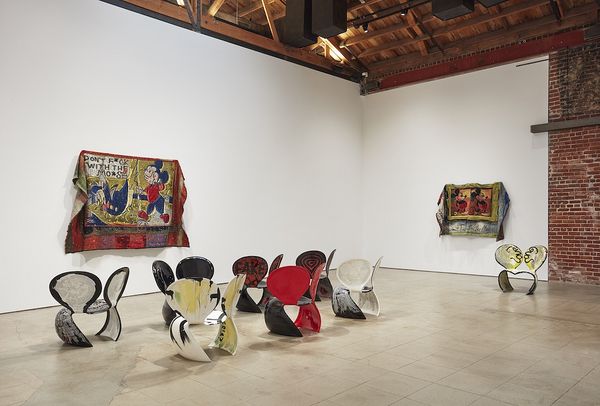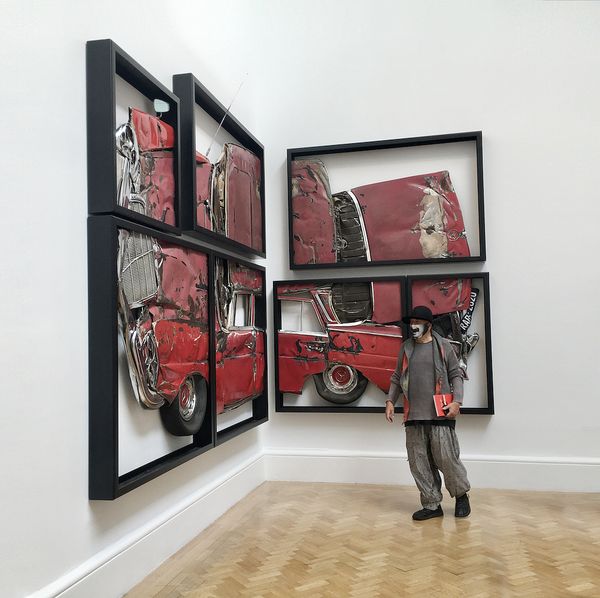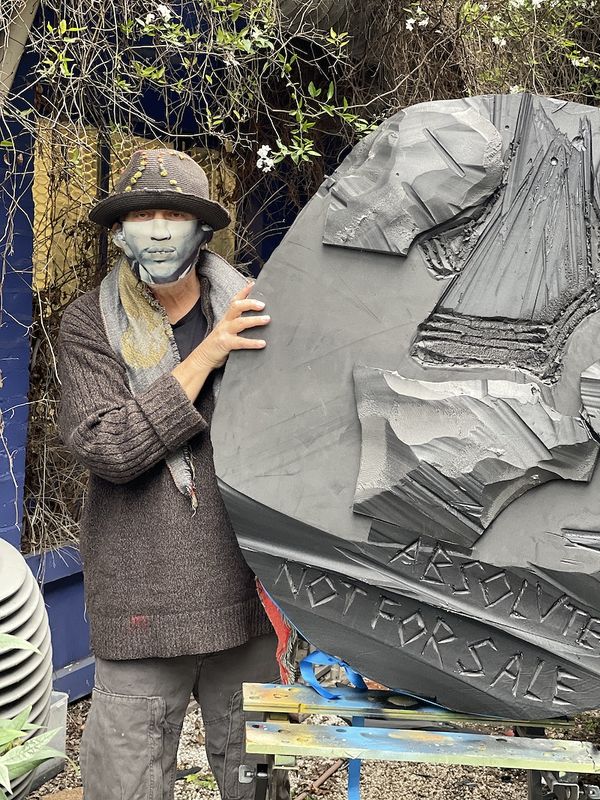Ron Arad, Tondo 2020, 2020.
SVETLANA MARICH: I will start with a very simple question. How did you come up with the idea the art piece that you're going to show at the 20th Century & Contemporary Art sale?
RON ARAD: In the lockdown, I found myself working with covers of things. I mean—like the covered Morgan car that I planned to exhibit at the Royal Academy Summer Show. I did my sketch, and when the fabric arrived from Belgium, where it was made, it was much better than I deserve. It was amazing. It had beauty that I was very lucky to get, and it was huge and big. I played with it, and that led me to covering things. I was working on the show in LA called Don’t F**k with the Mouse, which is to do with Mickey Mouse’s birthday. And there I did wall covers of works of art that are not there, like the Roy Lichtenstein Mickey Mouse, the stolen Andy Warhol double Mickey, the Damien Hirst, the Oldenburg geometric Mickey.
I did covers for them, so you don’t know if the piece is there or not under it, but I was interested in the fabric because it is, at least in my eyes, amazingly, amazingly, surprisingly beautiful and I fell in love with the process.
Then there was the controversy over the Michelangelo Tondo at the Royal Academy, as you know, some thought it was a good idea to sell the Michelangelo to save them from making people redundant and lose their jobs. When the debate cooled down (we cannot sell the family silver, our responsibility as a museum, etc) we were left with both sides of the argument, and I established a new relationship with the Tondo.
As I was in the process of covering things, I thought I’ll also wrap the Tondo, the beautiful piece that Michelangelo never finished, and maybe it's the first piece that he did when he moved to Florence. I had to sculpt a piece to go under the cover, to create the illusion of the volume under the fabric. I also carved the words "ABSOLUTELY NOT FOR SALE” (same as on the fabric). I thought I was working on an under cover object that no one will ever seesomething that no one will ever see, which buys you some freedom that you don't have normally.
Don’t F**k With The Mouse exhibition Over the Influence, Los Angeles 2020. Photo credit: Flying Studio.
SM: What is behind the idea of covering something that nobody can see?
RA: When you walk in the streets in my neighborhood, you see lots of cars that are covered in canvases and things, very Christo-esque, you know. You always imagine what's underneath. And I had the idea to sketch what we don’t see. And that was the starting point. Later because of the pandemic and everything that happened. I couldn’t exhibit the Morgan at the RA because of floor space restrictions and I found a different parking place for it, and I found a different parking place for the Morgan, and I did another piece even bigger, but it was a wall piece, which was called "OH LORD, WON'T YOU BUY ME" You know, the Janis Joplin song, the Mercedes Benz. I put the Morgan in Saville row, and I assembled the undercover car that I told you that I thought no one is going to see, but I fell in love with it because I looked at it and wow, I couldn't know which is better what's underneath or...? So normally you do an unveiling of the sculpture. We did a veiling, not the unveiling in Saville Row. So it was uncovered for a week, and then the ceremony was completely the opposite.
‘Oh Lord Won’t You Buy Me?’ Exhibited in the Royal Academy’s 2020 Summer Exhibition.
While doing that, I got involved with the Michelangelo, and the only time I went to the studio was to carve and to sculpt what goes underneath. Again, I did a piece that I thought no one was going to see. And then sadly, I liked it.
SM: And you have the message "Not for Sale" on the piece, even though at the end, your work is in our Contemporary Art sale.
RA: It is the age old dilemma. I wish I could keep it, but I can't because that's not the way it works.
SM: What do you think it added to the concept of the piece that is now to be sold at Phillips?
RA: First of all, when I finished it, I also became part of the public, the audience of it. I enjoyed it in a different way. I know it better, and it has something else. You see, and you don't see it. There is a thing that you have to think about, but you don't have to come to any conclusion. At the end of the day, it doesn't exactly matter where the delight comes from, as long as it’s there.
Ron Arad hand carves the underlying structure for the woven Tondo.
SM: What made you to shift from architecture to contemporary art?
RA: Do you have four hours to discuss it? When I showed talent in sketching and drawing, my mother, who was a painter, instead of saying “Ooh, he's going to be a great artist,” she said, “Ooh, he's going to be a great architect,” thinking wrongly that it's a safer profession. But when I studied architecture at the AA in the 1970s, the AA was more of an art school.
No one was building, and conceptual architecture was very jealous of conceptual art. That is my era. In my studio you don't need a passport to go from one discipline to the other. And indeed, when I had my retrospectives at the Pompidou center, and the MoMA, I called it "no discipline" because I'm not an exclusive member of any of the disciplines.
SM: How interesting that you speak about the fluidity of genres and disciplines. I think this is true that they're merging a lot today and it could be very hard. It's getting harder and harder to distinguish
RA: I took part in a conference about breaking the boundaries between disciplines, and I said, I think the more we discuss breaking the boundaries, the stronger you make the boundaries. So I think we should stop this discussion. And then the audience cheered, and the conference ended before it began.
Discover More from 20th Century & Contemporary Art Day Sale >
Recommended Reading
Banksy, Duchamp, Warhol, and the Readymade >
In Conversation with Collector Enea Righi >




